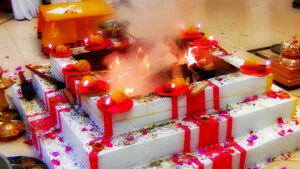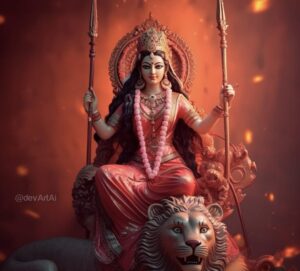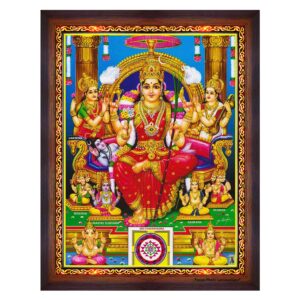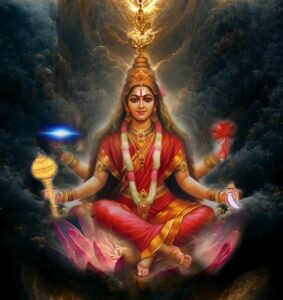As the sun sets on Navratri, the ninth day brings forth a distinctive celebration devoted to Goddess Siddhidatri, the bestower of divine blessings and supernatural powers. Her name is a fusion of “Siddhi,” representing supernatural abilities and “Datri,” signifying the giver.

Emergence of Siddhidhatri
The story of Siddhidatri is rooted in Hindu mythology and is closely associated with Lord Shiva’s intense penance. Here’s the tale of Goddess Siddhidatri:
Long ago, the universe was in a state of chaos. The gods were troubled by the demon Durgam, who had gained immense power and was causing havoc. The gods sought a way to combat this formidable force, but none were successful.
In their desperation, the gods turned to Lord Shiva, the supreme deity. To find a solution, Lord Shiva decided to delve into deep meditation. As he withdrew into profound contemplation, his meditation was so intense that it radiated a powerful energy.
Amidst Lord Shiva’s meditation, a divine light emerged from his left half. This radiant light took the form of a magnificent goddess. She was none other than Siddhidatri, the ultimate bestower of supernatural powers and spiritual accomplishments.

Siddhidatri, with her divine grace, granted Lord Shiva the powers of creation, preservation and destruction. Lord Shiva’s spiritual attainments were now complete and he had the capabilities needed to restore balance and harmony to the universe.
The eight primary forms of perfection, known as Ashta Siddhi, are mystical and supernatural attainments often associated with spiritual practices and divine blessings. These are highly revered in Hinduism and other spiritual traditions. Each of the Ashta Siddhi represents a unique divine gift that brings individuals closer to spiritual realization and mastery over the material world. Here are the eight forms of perfection:
- Anima: The ability to become infinitesimally small, allowing the practitioner to be present everywhere and perceive the tiniest details.
- Mahima: The power to expand one’s consciousness and physical presence infinitely, encompassing the entire universe.
- Laghima: The capacity to become weightless, allowing the practitioner to defy gravity and travel effortlessly through space.
- Garima: The power to become immensely heavy or dense, giving one immense strength and stability.
- Prapti: The ability to attain anything or be in any place at will, transcending the limitations of time and space.
- Prakamya: The power to fulfill one’s desires instantly and effortlessly.
- Ishita: The divine authority to control the elements, nature, and the material world.
- Vashita: The power to influence and control others’ minds and actions through spiritual authority.
Maa Siddhidatri, the giver of perfection, is believed to possess the ability to bestow these Siddhis upon her devotees. In the mythological story, her assistance to Lord Brahma and her role in converting half of Lord Shiva’s body into a woman highlight her immense power and significance in the cosmic order. This divine act was crucial for the creation of the universe and the balance of male and female energies, symbolized by the Ardhanarishwar form of Lord Shiva.
Depiction: Siddhidhatri is depicted as a divine goddess seated on a lotus flower, symbolizing purity and transcendence. She has four arms, holding a mace (gada), a discus (chakra), a conch (shankha) and a lotus (padma). These symbols represent her authority and control over various aspects of the cosmos.
Worship of Siddhidhatri: To worship Siddhidhatri during Navaratri, devotees follow these steps:
- Meditation: Begin with a meditation to calm your mind and connect with the divine energy of Siddhidhatri.
- Altar Setup: Create an altar or sacred space with an image or idol of the goddess. Decorate it with flowers, incense and a red or yellow cloth.
- Mantras: Chant mantras dedicated to Siddhidhatri, such as “Om Devi Siddhidhatryai Namah” or other relevant mantras.
- Offerings: Offer fruits, sweets and other pure vegetarian foods to the goddess as a symbol of your devotion.
- Aarti: Perform an aarti (a ritual of waving a lit lamp) in front of the goddess while singing devotional songs.
- Prayers: Offer your heartfelt prayers and seek her blessings for spiritual growth, enlightenment and protection.
- Distribute Prasad: On this auspicious day, devotees make offerings to the goddess, including coconut, kheer, naivedya, and panchamrit. Additionally, during the Kanya Pujan, people offer poori, halwa and kale chana to the goddess, which are lovingly distributed among the young girls along with thoughtful gifts. Share the offered food (prasad) with family members and friends.
Significance: Siddhidhatri is revered for her ability to bestow spiritual and mystical powers upon her devotees. Her worship signifies the successful culmination of the Navaratri festival, marking a new beginning filled with spiritual growth and divine blessings.
The worship of Siddhidhatri serves as a reminder of the divine feminine’s immense power, which encompasses creation, preservation, destruction and the ability to grant supernatural abilities to those who seek her grace. It symbolizes the culmination of one’s spiritual journey, leading to enlightenment and the realization of inner potential.
Author,
Sivalenka Neeraja





